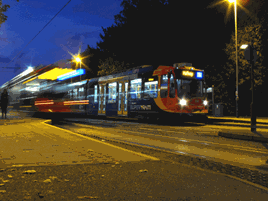Read part one of the Sheffield tram-train feature.
The first weekend I travelled to Sheffield (in October 1995, house hunting ahead of a new job), the city was in the middle of a celebration. Not (I hasten to add) for my imminent arrival, but for a much better reason. A full ten years since Parliament had signed off on the project, the last part of the Supertram network opened for business. Everyone was given three days’ free travel.
Hard to believe that was 20 years ago now. However, it’s even longer since the trams first returned to the city. It was back in March 1994 when passengers first boarded the grey-liveried Dusseldorf-built vehicles - the second revived tram network to open in the UK.
Sheffield had been the last English city to bid farewell to its traditional tram network - crowds had filled the streets on a dreadfully wet night in October 1960, and the event was even captured in a glorious BBC Children’s Unit newsreel. But some 34 years later, when they returned, the love affair took time to rekindle.
Rebuilding a largely ‘on street’ tram system had, not unnaturally, led to a good deal of disruption. Smaller businesses blamed lengthy road closures for robbing them of custom and forcing them to the wall.
And when the first part of the network opened it ran between the city centre and Meadowhall - this was just three years after the shopping complex opened, an event that had itself sparked a debate about taking life out of Sheffield’s High Street. Moreover, until ‘tram gates’ were installed at key junctions, traffic would often hold up the service.
However, ridership was the real worry. It had been thought that in excess of 20 million people would use it annually, but in the early days many trams rolled through the streets empty.
Various things were blamed. A complex ticketing system whereby passengers had to validate cards before boarding was just one of the reasons given (the cards had often been bought just moments before, from a separate machine).
Initially, the system was operated by a subsidiary company of the South Yorkshire Passenger Transport Executive. The four South Yorkshire councils had borrowed money towards the £240 million construction costs, but this meant taxpayers in Rotherham, Barnsley and Doncaster faced having to pay for the debt even though the system went nowhere near them. (Despite this, the official title of the network was a no doubt galling ‘South Yorkshire’ Supertram!)
Leafing through a file I’ve kept for posterity reveals a copy of a fax from early 1996. The councils had had enough, and called in consultants whose brief was “an urgent and considerable rethink about management and operation…” The document concluded that a plan needed to be identified for “a commercially profitable operation”.
Two years after opening, adverts appeared for the privatisation of the system - either as a franchise of the operation, or lock stock and barrel including assets. Stagecoach eventually took on the operation in 1997, with a licence that runs until 2024.
At that time ridership was pushing eight million people every year, which has now climbed to 12 million. That’s slightly (and understandably) down from a peak of more than 14 million a couple of years ago - this has been put down to the disruption caused by an extensive rail replacement programme.
The network consists of three lines, covering a little over 18 miles. One (as previously mentioned) connects the city centre to Meadowhall via Attercliffe. The old British Rail stations at Attercliffe and Brightside were closed as the trams and the new Meadowhall Interchange station opened.
The other lines are an altogether more complex proposition, snaking from Middlewood roughly southeast via the city centre towards Halfway. Some of this route is on street, some on new formation. Two short branches head to Malin Bridge and Herdings Park. The three existing passenger routes (Yellow, Blue and Purple) operate across the network to connect all these destinations.
The original Siemens Duewag-built vehicles are still in use, with 25 in the fleet. Usually 23 are required to run the service, with two in maintenance at the depot close to Nunnery Square stop. They can cope with maximum gradients of 10%, with the lines having steep climbs in places.
Over the years, there have been repairs and refurbishments to trams, changes to route patterns, and conductors have been introduced on board. The awkward ticketing is gone, and today you’ll often see services rolling past full, testament to how Sheffield has once again taken trams to heart.















Login to comment
Comments
No comments have been made yet.